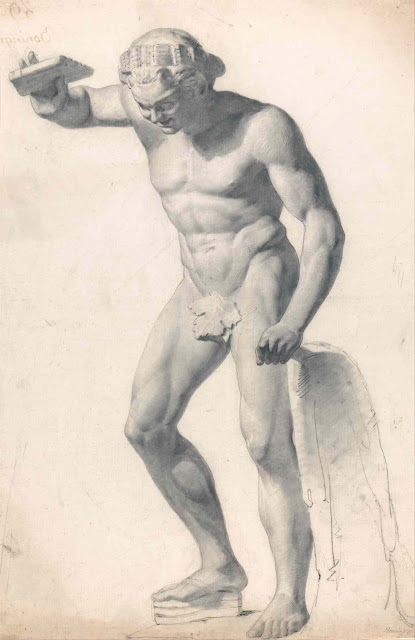 |
| Richard Parkes Bonington Cast of the so-called Faun of Praxiteles after an original in the Capitoline Museums, Rome (Academic study made in Paris) ca. 1819-22 drawing British Museum |
 |
| Richard Parkes Bonington Académie made in Paris 1820 drawing Fitzwilliam Museum, Cambridge |
 |
| Richard Parkes Bonington Cast of an antique statue of the Dancing Faun (Academic study made in Paris) ca. 1819-22 drawing Yale Center for British Art |
 |
| John Everett Millais Retribution, or, The man with two wives 1854 drawing British Museum |
 |
| John Everett Millais Study for the painting, Jephthah's Daughter ca. 1867 drawing British Museum |
 |
| Paul Musurus Man sitting in an armchair ca. 1855-65 drawing British Museum |
 |
| Paul Musurus Domestic interior by lamplight ca. 1855-65 drawing British Museum |
"And the degree to which poetry accords with nature may, I think, be seen from the fact that common, uneducated persons without any knowledge of letters or learning, if they have wit, enjoy the employment of their crude powers in making certain sounds and rhythms. Even when their sense would be better and more easily expressed in prose, they think they have made something worth hearing only when they have stuck it into verse. Again, when Mass is being said in church, we sometimes yawn and fall asleep even when it is being done very beautifully, but when once the poetical refrain breaks out, the Primo dierum omnium, or the Iste Confessor, or the Ut queant laxis resonare fibris, which of us is so earthbound as not to feel some lifting up of the soul, some inspired feeling? It is for this reason that certain of the ancients believed the soul to be a number and a harmony. It was certain (they thought) that all things in accordance with nature enjoyed that which was most similar and related to themselves, and there was nothing which so softened and delighted our souls as harmony and number. But this is another and greater subject. For the moment, this only do I wish to be understood: that it is to poetry, more than to any other branch of letters, that nature attracts us; that it possesses a great deal of utility, pleasure, and nobility; and that that man who has no knowledge of it can by no means be said to be liberally educated."
– from The Study of Literature, an essay written in Latin by Leonardo Bruni (1370-1444), translated by Craig W. Kallendorf and published in Humanist Educational Treatises (Cambridge, Massachusetts : I Tatti Renaissance Library, Harvard University Press, 2002)
 |
| William Rothenstein Portrait of the actor Constant Coquelin, called Coquelin aîné 1898 lithograph Fitzwilliam Museum, Cambridge |
 |
| William Rothenstein Portrait of Henry James 1898 lithograph Fitzwilliam Museum, Cambridge |
 |
| Horace Vernet Gabrielle Gauffrée modeling embroidered court-dress 1805 hand-colored engraving (from Journal des Dames et des Modes, Paris) Rijksmuseum, Amsterdam |
 |
| Édouard Vuillard Académie ca. 1890 drawing Minneapolis Institute of Art |
 |
| David Wilkie Model ascending a ladder 1840 wash drawing British Museum |
 |
| David Wilkie Two studies of recumbent model before 1841 drawing National Galleries of Scotland |
 |
| David Wilkie Study of three costumed figures on a ladder ca. 1835-38 drawing, with watercolor and colored chalk Fitzwilliam Museum, Cambridge |